 In July of 2023, Lorna and I sailed to England on the world's last ocean liner, the Queen Mary 2, and then we explored England and Scotland for 8 days. This was another "bucket-list" trip for me; I had wanted to experience a transatlantic sea crossing for a really long time, and Lorna and I were 30 years overdue to show each other our favorite parts of Scotland. That's all explained in the following pages.
In July of 2023, Lorna and I sailed to England on the world's last ocean liner, the Queen Mary 2, and then we explored England and Scotland for 8 days. This was another "bucket-list" trip for me; I had wanted to experience a transatlantic sea crossing for a really long time, and Lorna and I were 30 years overdue to show each other our favorite parts of Scotland. That's all explained in the following pages.
The trip was really three different parts: the elegant ship, rural England coming and going, and Scotland in the middle, over these days:

 On 27 August 2023, we had a traditional Russian feast with our friends
On 27 August 2023, we had a traditional Russian feast with our friends !["Pears Marinated in Spiced Cider Vinegar and Honey]"](/sites/default/files/inline-images/Food_Veg_PearsMarinatedInHoneyCiderVinegar_0.jpg) You might wonder why I have put a pear-and-honey recipe with the condiments instead of with sweets, but this recipe is a sort of sweet pickle that you serve with grilled meats or hearty fish dishes. The sweetness of the honey and the pears is balanced by the tart cider vinegar in which it marinates for a week.
You might wonder why I have put a pear-and-honey recipe with the condiments instead of with sweets, but this recipe is a sort of sweet pickle that you serve with grilled meats or hearty fish dishes. The sweetness of the honey and the pears is balanced by the tart cider vinegar in which it marinates for a week. I needed a cake to finish a paella dinner, so I searched for something Spanish. I found a whole class of citrus and olive oil cakes (Spanish cooking doesn't use a lot of butter), so I picked this easy Coca de Llanda version from Valencia.
I needed a cake to finish a paella dinner, so I searched for something Spanish. I found a whole class of citrus and olive oil cakes (Spanish cooking doesn't use a lot of butter), so I picked this easy Coca de Llanda version from Valencia.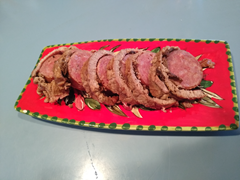 Cotechino in Camicia means "Cotechino in a shirt" because in this recipe the unctuous cotechino sausage is wrapped in a shirt of lean chicken!
Cotechino in Camicia means "Cotechino in a shirt" because in this recipe the unctuous cotechino sausage is wrapped in a shirt of lean chicken!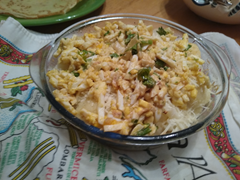 Camillo Benso, the Count of Cavour was a hugely important 19th century Sardinian and Piedmontese politician and patriot who also is known for his favorite dishes of traditional Piedmontese cuisine. Like many Piedmontese dishes, this one uses butter where recipes from more southerly states would use olive oil, and it uses the Grana Padano cheese of Piemonte and Lombardia where other dishes would use Parmigiano-Reggiano.
Camillo Benso, the Count of Cavour was a hugely important 19th century Sardinian and Piedmontese politician and patriot who also is known for his favorite dishes of traditional Piedmontese cuisine. Like many Piedmontese dishes, this one uses butter where recipes from more southerly states would use olive oil, and it uses the Grana Padano cheese of Piemonte and Lombardia where other dishes would use Parmigiano-Reggiano.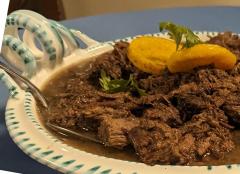 The Brasato al Barolo is a rightly celebrated main dish of Italy's Piedmont region, traditionally made using the local Barolo wine. That can become very expensive in this country, but driving through the Piedmont I was astonished to see €10 bottles of Barolo on endcap displays in highway rest areas! The best Barolos can fetch
The Brasato al Barolo is a rightly celebrated main dish of Italy's Piedmont region, traditionally made using the local Barolo wine. That can become very expensive in this country, but driving through the Piedmont I was astonished to see €10 bottles of Barolo on endcap displays in highway rest areas! The best Barolos can fetch 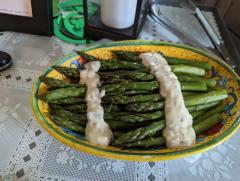 I was surprised when I first saw this. It's so simple, with no hard-to-get ingredients, that I would expect to see it on menus and at picnics and other al fresco dining opportunities. It seemed at first counterintuitive, but Tartar Sauce used to be used for many things beside fried fish, and this is just one simple example.
I was surprised when I first saw this. It's so simple, with no hard-to-get ingredients, that I would expect to see it on menus and at picnics and other al fresco dining opportunities. It seemed at first counterintuitive, but Tartar Sauce used to be used for many things beside fried fish, and this is just one simple example. 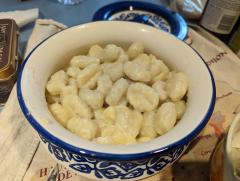 Here's a hearty cheesy dish from Italy's Piedmont region, and it's really simple and fast. Piedmont is at the foot of the Alps, and it's easy to see this as something nourishing and hot after hours of playing in the snow on a mountainside.
Here's a hearty cheesy dish from Italy's Piedmont region, and it's really simple and fast. Piedmont is at the foot of the Alps, and it's easy to see this as something nourishing and hot after hours of playing in the snow on a mountainside.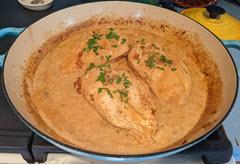 Here's another French dish with a creamy sauce, this time sparked up with paprika. You bake the breasts in a savory onion-butter-paprika base, then use that base on the stovetop to prepare a creamy sauce.
Here's another French dish with a creamy sauce, this time sparked up with paprika. You bake the breasts in a savory onion-butter-paprika base, then use that base on the stovetop to prepare a creamy sauce.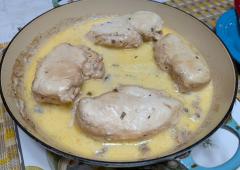 This dish of chicken breasts with mushrooms and a cider cream sauce is a hearty fall or winter dish. The chicken breasts (or thighs) are sauteed in butter with mushrooms, then flamed with calvados and braised in cider until tender and cooked through. Then the sauce is finished with heavy cream and an egg yolk to thicken it, making it awesome comfort food.
This dish of chicken breasts with mushrooms and a cider cream sauce is a hearty fall or winter dish. The chicken breasts (or thighs) are sauteed in butter with mushrooms, then flamed with calvados and braised in cider until tender and cooked through. Then the sauce is finished with heavy cream and an egg yolk to thicken it, making it awesome comfort food. 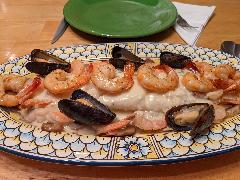 In late February of 2022 we had a feast to explore the classic cuisine of Normandy. As usual we had multiple courses including fish, meat, vegetables, a dessert, and regional drinks. Here's how we did it:
In late February of 2022 we had a feast to explore the classic cuisine of Normandy. As usual we had multiple courses including fish, meat, vegetables, a dessert, and regional drinks. Here's how we did it: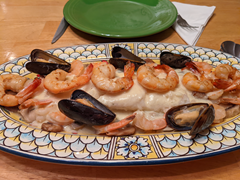 This recipe is built from three simpler recipes. First you poach the fish and save the poaching liquid, then you turn the poaching liquid into a Sauce Parisienne. At the same time on another burner, you make 1 quart of
This recipe is built from three simpler recipes. First you poach the fish and save the poaching liquid, then you turn the poaching liquid into a Sauce Parisienne. At the same time on another burner, you make 1 quart of